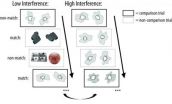It had been thought that the ion channels responsible for generating the photoreceptors' electrical response were activated by chemical messengers as is usually the case in cell signalling pathways. However, these results suggest that the light-sensitive ion channels responsible for the photoreceptor's electrical response may be physically activated by the contractions – a surprising solution to the mystery of light perception in the fly's eye and a new concept in cellular signalling.
Professor Roger Hardie, lead author of the study from the University of Cambridge's Department of Physiology, Development and Neuroscience, said: "The ion channel in question is the so-called 'transient receptor potential' (TRP) channel, which we originally identified as the light-sensitive channel in the fly in the 1990's. It is now recognised as the founding member of one of the largest ion channel families in the genome, with closely related channels playing vital roles throughout our own bodies. As such, TRP channels are increasingly regarded as potential therapeutic targets for numerous pathological conditions, including pain, hypertension, cardiac and pulmonary disease, cancer, rheumatoid arthritis, and ce rebral ischaemia. We are therefore hopeful that these new results may have significance well beyond the humble eye of the fly."
A fly's vision is so fast that it is capable of tracking movements up to five times faster than our own eyes. This performance is achieved using microvillar photoreceptor cells, in which the photo-receptive membrane is made up of tiny tubular membranous protrusions known as microvilli. In each photoreceptor cell, tens of thousands of these are packed together to form a long rod-like structure, which acts as a light-guide to absorb the incident light. Each microvillus also houses the biochemical machinery, which converts the energy of the absorbed light into the electrical responses that are sent to the brain – a process known as phototransduction.
As in all photoreceptors, phototransduction starts with absorption of light by a visual pigment molecule (rhodopsin). In microvillar photoreceptors this leads to activation of a specific enzyme known as phospholipase C (PLC). PLC is a ubiquitous and very well-studied enzyme, which cleaves a large piece from a specific lipid component of the cell membrane ("PIP2"), leaving a smaller membrane lipid (DAG) in its place.
Somehow this enzymatic reaction leads to the opening of "ion channels" in the microvillus membrane; once opened, these allow positively charged ions such as Ca2+ and Na+ to flow into the cell thus generating the electrical response. This basic sequence of events has been established for over 20 years; but exactly how PLC's enzymatic activity causes the opening of the channels has long remained a mystery and one of the major outstanding questions in sensory biology.
Professor Hardie added: "The conventional wisdom would be that one of the products of this enzyme's activity is a chemical 'second messenger' that binds to and activates the channel. However, years of research had previously failed to find compelling evidence for such a straightforward mechanism."
The new study, which was funded by the BBSRC and the Medical Research Council, using the fruitfly, Drosophila, now suggests a remarkable and unexpected resolution to this mystery. The key finding was that the photoreceptors physically contract in response to light flashes. The contractions were so small and fast that an "atomic force microscope" was needed to measure them. This revealed that the contractions were even faster than the cell's electrical response and appeared to be caused directly by PLC activity.
The researchers believe that the splitting of the membrane lipid PIP2 by the enzyme PLC reduces the membrane area, thereby increasing tension in the membrane and causing each tiny microvillus to contract in response to light. The synchronised contraction of thousands of microvilli together then accounts for the contractions measured from the whole cell.
Dr Kristian Franze, co-author of the paper from the University of Cambridge, said: "We propose that within each microvillus the increase in membrane tension acts directly on the light-sensitive channels. In other words, rather than using a traditional chemical 2nd messenger, the channels were being activated mechanically."
This concept was supported by experiments in which the native light-sensitive channels were eliminated by mutation and replaced with mechano-sensitive channels, which are known to open in response to membrane tension. Remarkably, these photoreceptors still generated electrical signals in response to light, but were now mediated by activation of the ectopic mechano-sensitive channels. To test whether the native light-sensitive channels could be affected by mechanical forces in the membrane, the microvillar membrane was stretched or compressed by changing the osmotic pressure. This simple experimental manipulation rapidly enhanced or suppressed channel openings in response to light as predicted.
These results suggest that PLC mediates its effects in the photoreceptors by changing the mechanical state of the membrane. The researchers suggest that it is the increase in the membrane tension (along with a pH change also resulting from PLC activity) that triggers the opening of the light-sensitive channels. Mechano-sensitive ion channels are actually well known, but normally involved in transducing mechanical stimuli – such as sound in the ears or pressure on the skin. One of their characteristics is that they can be activated extremely rapidly – perhaps an explanation for why fly photoreceptors have evolved this solution to phototransduction.
Professor Hardie said: "That a mechanical signal could be an intermediate signal -or 'second messenger'- in an otherwise purely biochemical cascade is a novel concept that extends our understanding of cellular signalling mechanisms to a new level." ###
For additional information please contact:
Genevieve Maul, Office of Communications, University of Cambridge
Tel: direct, +44 (0) 1223 765542, +44 (0) 1223 332300
Mob: +44 (0) 7774 017464
Email: Genevieve.maul@admin.cam.ac.uk
Notes to editors:
1. The paper 'Photomechanical responses in Drosophila photoreceptors' is scheduled to be published in Science on 12 October 2012.
2. Videos and images available.
3. About BBSRC - BBSRC is the UK funding agency for research in the life sciences and the largest single public funder of agriculture and food-related research.
Sponsored by Government, in 2010/11 BBSRC is investing around £470 million in a wide range of research that makes a significant contribution to the quality of life in the UK and beyond and supports a number of important industrial stakeholders, including the agriculture, food, chemical, healthcare and pharmaceutical sectors.
BBSRC provides institute strategic research grants to the following:
The Babraham Institute, Institute for Animal Health, Institute for Biological, Environmental and Rural Studies (Aberystwyth University), Institute of Food Research, John Innes Centre, The Genome Analysis Centre, The Roslin Institute (University of Edinburgh) and Rothamsted Research.
The Institutes conduct long-term, mission-oriented research using specialist facilities. They have strong interactions with industry, Government departments and other end-users of their research. For more information see: http://www.bbsrc.ac.uk
4. The Medical Research Council (MRC) is a publicly-funded organisation. Its business is medical research aimed at improving human health. The research it supports and the scientists it trains meet the needs of the health services, the pharmaceutical and other health-related industries and the academic world. MRC has funded work which has led to some of the most significant discoveries and achievements in medicine in the UK.
For more information, see: http://www.mrc.ac.uk/index.htm


